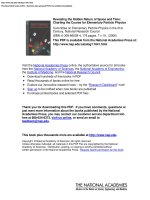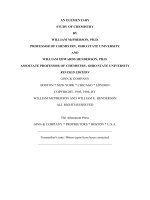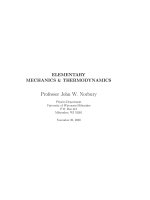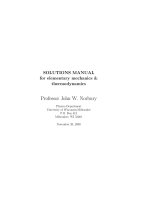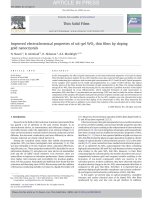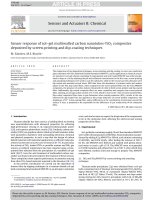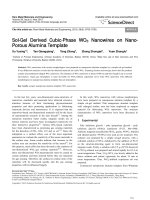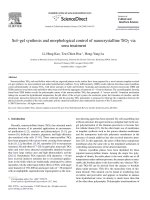Elementary diff eqs 8e sol earl rainville
Bạn đang xem bản rút gọn của tài liệu. Xem và tải ngay bản đầy đủ của tài liệu tại đây (11.89 MB, 242 trang )
Student Solutions Manual
Phillip E. Bedient * Richard E. Bedient
Eighth Edition
Elementary
Differential
Equations
Earl D. Rainville
Phillip E. Bedient
Richard E. Bedient
Student Solutions Manual
Phillip E. Bedient ¢ Richard E. Bedient
Eighth Edition
Elementary
Differential
Equations
Earl D. Rainville
Late Professor of Mathematics
University of Michigan
Phillip E. Bedient
rofessor Emeritus of Mathematics
Franklin and Marshall College
Richard E. Bedient
Professor of Mathematics
Hamilton College
PRENTICE HALL, UPPER SADDLE RIVER, NJ 07458
www.pdfgrip.com
Assistant Editor: Audra Walsh
Production Editor: Carole Suraci
Special Projects Manager: Barbara A. Murray
Supplement Cover Manager: Paul Gourhan
Manufacturing Buyer: Alan Fischer
Copyright © 1997 by Prentice-Hall, Inc.
A Pearson Education Company
Upper Saddle River, NJ 07458
All rights reserved. No part of this book may be
reproduced in any form or by any means,
without permission in writing from the publisher.
Printed in the United States of America
ISBN
O-13-592783-6
Prentice-Hall International (UK) Limited,London
Prentice-Hall of Australia Pty. Limited, Sydney
Prentice-Hall Canada Inc., Toronto
Prentice-Hall Hispanoamericana, S.A., Mexico
Prentice-Hall of India Private Limited, New Delhi
Prentice-Hall of Japan, Inc., Tokyo
Pearson Education Asia Pte. Ltd., Singapore
Editora Prentice-Hall do Brasil, Ltda., Rio de Janeiro
www.pdfgrip.com
Definitions; Families of Curves
12
Definitions.
2.
peak
frank
Contents
Numerical
2000.
ee
ee es
. 000.0
000 eae
.
ee
te ee
......0....0....00050000.
0
ee
tee
rar
The General Solution of a Linear Equation
2...
et
Ch bt
2.6
Miscellaneous Exercises
ee
font
Equations of Order One
2.1 Separation of Variables...
0...
2.2 Homogeneous Functions .. 0...
2.3 Equations with Homogeneous Coefficients...
2.4 Exact Equations 2... 0.
tO Crotn
no
peek
et ee
Methods
3.2
Euler’s Method
3.3.
3.4
3.5
3.6
3.7
3.8
A Modification of Euler's Method. . 0... 0
ee te
as
A Method of Successive Approximation .. 2.6.0.0...
00.000 eee eee
AnImprovement 2.0.0
ee
eee
ees
The Use of Taylor’s Theorem .. 0.00.0
ee ee
The Runge-Kutta Method...
0.0.0 0.
ne
A Continuing Method 2.00.0. ee
ee
. 2...
eee
Elementary Applications
4.3
Simple Chemical Conversion. 2... 00
4.4
Logistic Growth and the Price of Commodities
......0.00.0
ee
0.0.0.0.
Additional Topics
on Equations of Order One
5.1 Integrating Factors Found by Inspection...
...-.00 00.00.0020
5.2 The Determination of Integrating Factors .......0.00 2.00000.
5.4 Bernoulli's Equation... 0.
5.5 Coefficients Linear in the Two Variables 2... 6
5.6 Solutions Involving Nonelementary Integrals...
0.0.
www.pdfgrip.com
ee ee
00050.
0000008
02 405 0G
ee
ee
ee
21
22
22
22
23
24
24
25
25
26
CONTENTS
6
Linear Differential Equations
6.2 An Existence and Uniqueness Theorem
...........0..00000000-00.
6.4 The Wronskian 2.0...
eee
ee eee
6.8 The Fundamental Laws of Operation... 2.0000
0
ee 00
ee ee ee
6.9 Some Properties of Differential Operators .......000..
0000...
cay ae
39
39
39
40
41
7
Linear Equations
with Constant Coefficients
7.2 The Auxiliary Equation: Distinct Roots ........0..00...0. 0200005 cas
7.3 The Auxiliary Equation: Repeated Roots .......0..00.000. 0.00000008
42
42
43
7.6
A Note on Hyperbolic Functions
Miscellaneous Exercises
8
9
...0.0.00000
000 ee 0000
ee et ae
20.
ee
eee
44
ee
45
Nonhomogeneous Equations: Undetermined Coefficients
8.1 Construction of a Homogeneous Equation from a Specific Solution ..........
8.3 The Method of Undetermined Coefficieents 2.2.
0.0 0.0. ee
8.4 Solution by Inspection...
2.1.
48
48
49
54
Variation of Parameters
56
9.2
Reduction of Order...
0.
9.4 Solution of y’+ y= f(@)
0.
ee
eee
ee
56
ee
«BB
eee
10 Applications
10.3 Resonance
70
60.
70
10.4 Damped Vibrations. ©. 0. ee
10.5 The Simple Pendulum ©. 1... ee
11 Linear Systems of Equations
11.2 First-Order Systems with Constant Coefficients
11.4 Some Matrix Algebra 20
11.5 First-Order Systems Revisited. 2. 0
11.6 Complex Eigenvalues 0 00 0
11.7 Repeated Eigenvalues 2. 0.
11.8 The Phase Plane
12 Nonhomogeneous
. 0.0
13 The Existence
00 0.
ee
ee
ee
ee
tet
ee
es
ee
73
77
78
78
78
79
81
83
85
0
Systems of Equations
12.1 Nonhomogeneous Systems
19.2 Arms Races...
12.4 Simple Networks
©...
ee
ee
ee
2.
87
87
ee
6 0
88
eee
2...
and Uniqueness
of Solutions
13.2 An Existence and Uniqueness Theorem...
6 6 0 eeee
www.pdfgrip.com
90
94
94
CONTENTS
14 The
14.3
Laplace Transform
‘Transforms of Elementary Functions
14.6
14.10
FunctionsofClassA
Periodic Functions...
2...
95
.......00000.0.......0004..,
0...
ee
ee eee,
eee
15 Inverse Transforms
15.1
15.2
101
Definition of an Inverse Transform
Partial Fractions ©...
..
2...
ee
15.3 Initial Value Problems .. 0.0.0...
15.4 A Step Function «2.0...
15.5
A Convolution Theorem
16.2
16.56
16.7
16.9
ee
eee
ee
ep
2.0.
15.6 Special Integral Equations...
15.8 The Deflection of Beams...
15.9 Systems of Equations...
16 Nonlinear
ee
ee
ee
ee
2...
2... ee
2.
ee
eee
102
108
eee
110
eg
111
14
115
tt
ee,
120
2...
2
nt
ee
te
Series Solutions
18 Solutions Near Regular
....
Singular Points
Regular Singular Points
2.2...
Difference of Roots Nonintegral
184
ee
143
ee
143
. 2...
Equal Roots...
18.7
Equal Roots, an Alternative...
0.
18.8
Nonlogarithmic Case...
18.9
Logarithmic Case.
ke
18.10
18.11
Solution for Largez oe
Many-Term Recurrence Relations 2...
ee
ee
152
158
ee
eee
160
ee
ee ns
174
181
et es
185
» ees
205
205
2 0
2.0.
131
143
0.
18.6
Miscellaneous Exercises
120
123
124
126
134
17.5 Solutions Near an Ordinary Point... ... . —
18.4
101
102
Equations
Miscellaneous Exercises
18.1
ee,
Factoring the Left Member
.......0...000000
000.0... 00 000 vp eae
The p-Discriminant Equation ©... 0
ct
ee ee
Clairaut’s Equation. 2 0
te
een,
Independent Variable Missing...
0.0.00.
17 Power
95
96
98
165
ee
20 Partial Differential Equations
20.3 Method of Separation of Variables
21 Orthogonal Sets of Functions
208
21.6 Other Orthogonal Sets...
ee
22 Fourier Series
22.3 Numerical Examples of Fourier Series
22.4 Fourier Sine Series 20
2...
0.2
www.pdfgrip.com
ee
ee
208
210
210
213
CONTENTS
23 Boundary Value Problems
23.1 The One-Dimensional Heat Equation... .........0...
23.4 Heat Conduction ina Sphere .. 0...
2. ee
es
23.5 The Simple Wave Equation ........0.-.
205. ee ue
23.6 Laplace’s Equation in Two Dimensions. .............
24 Additional Properties of the Laplace Transform
24.1 Power Series and Inverse Transforms
24.2 The Error Function. 2. 0. 0
24.3 Bessel Functions
. 2... 0
.... 0.0.0.0...
0006
es
25 Partial Differential Equations:
Transform Methods
25.1 Boundary Value Problems...
25.2 The Wave Equation
2.0.00
....000.-.0
ee
25.5 Diffusion in a Slab of Finite Width...
25.6 Diffusion in a Quarter-Infinite Solid
00250005
ee
ee
ee
2. .0.......0..
2. .......0..0..0.
www.pdfgrip.com
Chapter
1
Definitions; Families of Curves
1.2
Definitions
All answers in this section are determined by inspection.
1 . The equation is ordinary, linear in x, and of order 2.
cn
3. The equation is ordinary, nonlinear, and of order 1.
The equation is ordinary, linear in y, and of order 3.
7. The equation is partial, linear in u, and of order 2.
9. The equation is ordinary, linear in x or y, and of order 2.
il. The equation is ordinary, linear in y, and of order 1.
13. The equation is ordinary, nonlinear, and of order 3.
15. The equation is ordinary, linear in y, and of order 2.
1.3.
Families
of Solutions
1. Rewriting the equation yields y = / a? + Idx +c. Integrating, we have y = gx! + 2% +46,
Rewriting the equation yields y = 4 / cos 6a dx + ¢. Integrating, we have y = 2 sin Oz +c.
Rewriting the equation yields y = 2 /
1
ye
dz+c. Integrating, we have y = arctan (2/2)+c.
. Rewriting the equation yields y = 3 / e* dz. Integrating, we have y = 3e* +c,
the initial conditions gives 6 = 34+ corc=
Substituting
3 so y = 3e7 +3.
As in Example 1.2, y = ce**. Substituting the initial conditions gives 3 = ce® = c so y = 3e%*,
11. Rewriting the equation yields y = 4 / sin 2a dx. Integrating, we have ~2cos2¢+c.
ing the initial conditions gives 2 = -2cos7 +e = 2+corc=0s0
www.pdfgrip.com
y = —2c0s 2u.
Substitut-
CHAPTER 2.
Chapter
EQUATIONS OF ORDER
ONE
2
Equations of Order One
2.1
Separation of Variables
1. The variables may be separated to give
[tana
few
r
Integrating both sides we have
Inr = ~-2¢ +corr=e =2t? +e orn
=
nt?
677 6,
To simplify this we replacing, the constant e° by another constant. We could use a different
name like k to get, r = ke~?*', but the convention is to reuse the name c to obtain
r= ce
oe
2t
BF
or To = €or Tr = To exp (—2t").
The variables may be separated to give
y
wee dy =
lies,
¥
dz
fm.
x
Integrating both sides we have
din(l+y*) =Ina+cor In(i+y*)/? =Ing+e.
Exponentiating both sides yields
(1 y2)¥2 = ell 49 op (1 $y?)
ax elt tee,
As in Exercise 1 replacing e° with ¢;
(1+y?)\/? = ex or y* = cz? -lory= Vex? — 1.
From the given conditions, 3=
/4¢~-1,
9=4e-1lorc=
y= 3 V 100? - 4.
www.pdfgrip.com
42. Thus
2.1.
SEPARATION OF VARIABLES
3
. Separating the variables we have,
2{Z=3
ay
xr
y
Integrating both sides yields, 2Ina +¢ = 3iny or y? = cz.
conditions to obtain, 1 = 4c, or c = 4. Thus y = (x/2)?/8.
Finally, we substitute the initial
. Separating the variables we have,
[eva
= [oe
dz.
Integrating both sides yields, -e7~¥ = —ten
-+-c. Finally, we substitute the initial conditions
to obtain, -1 = -i =corc= —}. Thus 2e7Ơ = e~đ +1 or In2- y = In (e-™” +1) or
y = In2 —In[1 + exp (—2")).
. Separating the variables we have,
2a? [r-8dr—
fran
= f
sins,
Integrating both sides yields, ~a?r~? —Inr = —cos@+.c.
Finally, we substitute the initial
conditions to obtain, ~a?a~? — Ina = ~—cos0 +c or -Ina = c. Thus ~a2r7? ~Inr
—cos@ ~ Ina or r*(Inr — Ina) = r? cos@ — a? or r* In(r/a) = r? cos8 — a?.
=
11. Separating the variables we have,
[a-/
da:
yf
i-«
Integrating both sides yields, ~y~! = ~In(1 ô)+c. Replacing  by Inc, yjln|1 el+ine] = 1.
Thus yin |e(1 — z)j = 1.
13. Separating the variables we have,
dy _
adz
Integrating both sides yields, —}y~? = hers” +c. Replacing —2e by c leaves e~™ + y7? = c.
16. Separating the variables we have,
mde _ fndy
z
¥
Integrating both sides yields, mlng = niny +c or 2™ = cy”.
17. Separating the variables we have,
[%-Vv
aP
Po
Integrating both sides yields, nV = ~ln P+corin(PV)=cor PV =e,
www.pdfgrip.com
CHAPTER 2.
EQUATIONS
OF ORDER
ONE
19. Separating the variables we have,
[*
bsin é dé
r
|
1—bcosé’
Integrating both sides yields, In |r| = In|1 — bcos @| + ¢ or r = c(1 ~ bcos @).
ai. Separating the variables we have,
[uev=-[
Zyae=-f
(+045)
dz.
Integrating both sides yields, dy? = —(a+1)?—In (x — 1)+c or (x+1)? +y? +2 In |e(x — 1)| = 0.
23. Separating the variables we have,
[a
Integrating by parts yields, / (i +
Thus -
— i
=~
| xe* de.
| dy = —ze* + / e” dz.
= ~—ze* +e" +c or e*(a — 1) = (2y + 1)/(2y") +e.
25. Separating the variables we have,
fue
dy = [eo
dz.
Integrating both sides yields, —ye~¥ + / e-8 dy = —a7' +c. Thus ~ye7¥ ~ e74 =~
+6
or c(y +1) = (1+ czr)e¥.
27. Separating the variables we have,
J secudy = [cost xa.
Integrating both sides yields, In|secy + tany| = da + ; sin 2n + c.
Thus 4In]secy+ tanyj] = 2x + sin 2x + ¢.
29. Separating the variables we have,
[cost xa
= fe
+t?) dt.
Integrating both sides yields, 42 + 4sin 2x = 4(1+¢)? +c. Thus 2z+sin22 =e+ (1407).
www.pdfgrip.com
2.2.
31.
HOMOGENEOUS FUNCTIONS
5
Separating the variables we have,
[tBan- [has
or
[ (E43) aa=- f (G41) a8
Integrating both sides yields, Ina + 3a = ~Inf—§8+c
caf = exp{—3a — ~).
or lnaf = ~3a~ B8+c.
Thus
33. Separating the variables we have,
rdz
/ dy
va? — x3
Integrating both sides yields, -/a? — x? = y +c. Thus y—-c¢ = ~Va? — 2”, the lower half of
the circle x? + (y — c)? = a?.
35.
Separating the variables we have,
a? dx
aye
=f
aVvx* — a?
/
LY,
y+e
Integrating both sides yields, a aresec(t/a) = y +e. Thus x = asec y
37. Separating the variables we have,
2
_fyti,
x
_
lane: [tae
/(v
_
1+
2
ty) dy
Integrating both sides yields, § In (2* +1) = $y? —y+2Inly+1j+e.
Thus In (x? + 1) = y? — 2y + 4 In |e(y + 1).
2.2
Homogeneous
Functions
All functions are homogeneous except those of Exercises 2, 5, 6, and 19 by examination.
2.3.
Equations
1. Substituting
y
with Homogeneous
=
av,
we
have
3(327
Coefficients
+ v*z*)dr
—
(9 + v) da = Qrvdv. We first separate the variables to obtain
[e-2/
udu
x
9 + 2"
Integrating yields Inc = In(9+ v7) +c.
x = [9 + (y/x)*] or 2° = c(9x? + y*),
22?u(ude
+ xdv)
=
O
or
Replacing ¢ by Inc and substituting for v leaves
www.pdfgrip.com
CHAPTER 2.
EQUATIONS OF ORDER
3. Substituting y
= av, we have 2(227 + v?x?)dx — x*v(ude
(4+v7)dx = xcudu. We first separate the variables to obtain
/ dx
/
gc
Integrating yields Inz = 3 In 1 (4 +v*) +c.
f
+ adv)
ONE
=
0
or
vdy
442!
Replacing ¢ by Ine and substituting for v leaves
x? = c7[4 + (y/x)*] or ct = ce? (da? + y?).
. Substituting
y
=
xv,
we have
(4a* + Tux? + Quta*)dz — a?(udz + xdv)
=
0, or
(4+ 6v + Qu") dx = xdu. We first separate the variables to obtain
[e-
loss
du
4+6u+
-4/
202
1
+
1
2Q+u
d
itv
Integrating yields Ina = }(In(2+v) In(1+v)] +<Â or
a
leaves Â[1 + (y/x)] = ô7[2 + (y/z)] or x?(y + 2x) = c(y + 2).
°-
= c*z*. Substituting for v
. Substituting y = cv, we have (2 ~ xv)(4z + av)da + x(5a — xv)(vdx + xdv)
(—2u? + 2u + 4) dx = (—5a + xv) du. We first separate the variables to obtain
dx
ve 5
1
[¢ =| sete’
1
0 or
2
-1f (=5+sh)
e(v
— 24/2
Integrating yields Inz = —}In(v ~ 2) —In(v+1) +c or
=
vt
dv.
= z, Substituting for v
leaves e[(y/x) — 2]!/? = a[(y/x) +1] or z(y + z)* = c*(y — 22).
. Substituting z = yu, we have (v2y? + 2y?v — 4y*)(udy + y du) — (uy? — 8y?u — 4y”) dy = 0 or
(v? + v? + 4u + 4) dy = ~y(v? + 2u — 4) dv. We first separate the variables to obtain
[*--[
yo
i
he-/
we+vrtdu+4 0 —
Integrating yields Ina = In (v + 1) ~ In(v? + 4) +c, or
1
v+t1
vt
ed
ay
vi+4
=: y. Substituting for v leaves
yl(y/a)? + 4] = c[(y/x) + 1] or 2? + 4y? = e(a + y).
i. Substituting
y
=
av,
we
have
(2?
+
v*z*)de
/
vw
1+2v?
+
z*u(udz
(1 + 2v”) dz = —zu dv. We first separate the variables to obtain
/ dx
ce
J
+
cdv)
=
0
or
Integrating yields ~Inz = 41In(1+?) +e, or (1 + 2u*)/4z = c. Substituting for v leaves
[1 + 2(y/x)?]a4 = ef or 2?(2* + 2y?) = ct.
www.pdfgrip.com
2.3.
EQUATIONS
WITH HOMOGENEOUS
COEFFICIENTS
7
13. Substituting 2
=
vy,
we have v*(udy + ydv) +
(y? + 2y) du = —udy. We first separate the variables to obtain
- [=
at
ve
=a
Jf w+oy 2
yu(yy
il
yo
\,
y+2
+
v)dv
=
O
or
y.
1/2
}
=>
Substituting for y leaves
a
Integrating yields — Inv = g(Iny —In(y+2)}+eor € 2
c{(z/v) + 2] = (x/v)u* or xv? = efx + Qu).
16. Substituting yo = rv, we have 3 + susin 2) dx — asin Foy dx + xdv)
=
(2 + zusin®
v — usin? v) dz = x* sin? udu. We first separate the variables to obtain
dx
x
O
or
= | sin* vav.
1
Integrating yields Ing = 3Ui sin2v +c. Replacing c by Inc and substituting for v leaves
In |z/el= 4(y/x) — 4 sin (2(y/x)] or 4a in |x/e| ~ 2y + vsin (2y/x) = 0.
17, Substituting y = xv, we have (« — zvarctanu)dr + xarctanv(vdr + xdv) = 0 or
—(i — varctanv + varetanv) dz = xarctanudv. We first separate the variables to obtain
-{2
x
Integrating
yields
2
2
In eee)
~Inz
=
+c
=
= f asctanv do.
varetany
Qvarctanyv.
Then
—
4 In(l
+7).
substituting
for
Replacing
vu gives
¢ by
Inc
leaves
=
0 or
2
2
In (Eege*)
x
= 2(y/x) arctan (y/x) or 2y arctan (y/x) = x In [c?(x? + y*)/24}.
19. Substituting
t = sv, we have vs(s* + v%s?)ds — s(s? — v?s?)(uds + sdv)
(v +3 —v +") ds = s(1 — v*) dv. We first separate the variables to obtain
ds
seme
/ 8
SE
fi-v?
1
—————1) =
“3 yn
we
9 ~ 3 / (eno)
de
.
Integrating yields In |s| tes= 4(—4u7?—In[u}) or Injesv!/?|= ~jv*. Substituting for v leaves
—2t? in |es?(t/s)|= s? or s? = ~2#? In jest}.
al. Substituting
y
=
xv,
we
have
(3x?
— 227y
+ 327v")
de + 4z*u(udz
+ zdv)
(3— 2u — v*) dx = drvdv.
We first separate the variables to obtain
dz
/?
du
-/[sE=3
god
i”
—3
1
=-/[(St)
do.
Integrating yields Ing = ~3In(34+v)—-In(l—v)4+e
Substituting for v leaves z[3 + (y/x)P{1 ~ (y/x)] = c or (y — x)(y + 3x)? = ex.
www.pdfgrip.com
=
0
or
CHAPTER 2.
EQUATIONS OF ORDER
23. Substituting
y = «xv, we have (x — zu)dz + (382 + zv)(ude + adv)
(l—v+3u +07) dz = —(3+ v)zdv. We first separate the variables to obtain
dz
-{¢
3+4
-/ ase
1
=f
for v leaves
Gs
or
2
ino™
dy
In[z(1 +v)| +c. Substituting
= Infa(1 + [y/2])] + ¢ or 22 = (2 + y) In (aw + y) + e(a + y). The initial
conditions give 6 = (1) In@ij)+e=c,
25,
0
2
(+a)
Integrating yields —Inx = In(1+v)~2(1+u)7!+cor
=
ONE
Thus 2(2r + 3y) + (@ + y) Infe+y) = 0.
Substituting y =
zu, we have (rv + Ja? +a%v?)dx — a(udr
(v+ V1 + vu? — v)dz = adv. We first separate the variables to obtain
+ xdv)
=
0
or
dy
Jitu?
Integrating
27.
yields
Inn
=
xz = ef(y/x) +
zg? =Qyt+l.
/1+ (y/z)*].
Substituting y
=
In(vu+Vl+v7)
+
«
Substituting
for
vu
leaves
The initial conditions give 3 = c(1+/3+1) orc = 1. Thus
xv, we have (x*v? + 7x*v + 16z*)dr + 2°(udz + 2dv)
=
0 or
(vu? + 7v +164 u)dx = ~—xdv. We first separate the variables to obtain
[¢Integrating yields Inz = —
ees
rs ie -/ oe
+c. Substituting for v leaves [(y/x) + 4]Ing = 1+ ¢[(y/x) + 4).
The initial conditions give 0 = 1+ 5¢ or c = ~—(1/5).
a2-y=5(yt+4z) ing.
Thus (y+ 4c) Ing = x — By + 4x) or
29. Substituting
c =
yv, we have yv(ydu + udy) + 2(y7u?
(u? + Qu? + 4) dy = —vy du. We first separate the variables to obtain
+ 2y2)dy
=
O
or
dy
v
-{% -f a pat
Integrating yields ~Iny = 3 In(3v? + 4)+c. Substituting for v leaves c = In ([3(x/y)? + 4]y®).
The initial conditions give C== 4. Thus y4(32? + 4y?) = 4,
31. Substituting
y
=
xv,
we
have
au(Qx — 2xv)dx
— 2(64 ~ cu)(vdz + adv)
(Qu ~ 2u? — 6v + vu?) dz = (6 ~v)adu. We first separate the variables to obtain
[2- [arene [qo=ae=
[Go sea) *
www.pdfgrip.com
=
0 or
2.4.
EXACT EQUATIONS
9
Integrating yields Ing = 2lnv ~In(v —3)+c¢.
_
2*(y
—
32)
Th
c= ———~;-——. The
Seated
‘a2
.
Substituting for v leaves c = al(y/z) = 3]
(y/z)?
a
_
initial conditions give c = {1(1 ~3)|/1 = —2.
rn
2_.
Thus —2y*
or
2
= 2?(y — 32) or
¥
33 — zy — 2y? = 0.
33. Substituting y = av, we have (16x + 5xu)dx + (3x + rv)(udx + x2dv)
(16 + 5u + 3u + v*) dz = (~3 — v)rdv. We first separate the variables to obtain
-[S-
flatts
v+3
v= |
wtb pie.”
Integrating
yields
—-Ing
=
1
~In(ai(y/2) +4) = Gog
In(v+4)
ter
—In(-3+4)
= 1/(-3+4)+core
yt 3e = (y + 42) In (y + 42).
_t
+
ny
(v + 4)
1
1
v+4
(u4+4)?
+6
=
0
or
dv
‘
Substituting
for
vu
leaves
£
+4) = ae
= —1.
+c. The initial conditions give
Thus —(y + 4x) In(y+42) = xc - y — 42 or
35. Substituting
2 = yv, we have 2y*v(ydu + udy) — (8y2v?
(3u? — 2 — 2v*) dy = Quy dv. We first separate the variables to obtain
— 2y7)dy
=
0
or
dy
Integrating yields Iny = In(v? —2)+
¢.
Substituting for v leaves In (ars)
= ¢ OF
3
Cc=
2.4
gop
orc = 1/2. Thus 2? = 2y?(y +1).
Exact
Equations
OF
1. Let an 72 +y. Integrating with respect to z we have F = x7/2+2y+T(y).
with respect to y yields x
cor 2? +Iry
OF
Let a
¢
Differentiating
= 2+T"(y) = ¢-y so T(y) = —y?/2. Thus F = 2?/2+2y—y?/2 =
~yr=c.
2
= 2xy—32*.
.
.
4
2
3
Integrating with respect to x we have F = 2*y~2°+T(y).
:
sae
Differentiating
with respect to y yields 3 = x? +T7"(y) = 2? +y so that T(y) = y?/2.
Thus F = a2?y— 23 + y?/2 = cor x*y— 23+ $y? =e
. LetoF
ax
= c~2y. Integrating with respect to x we have F = x7/2—2zy+T(y).
with respect to y yields &
= —22+T"(y) = 2y — 2x so that T(y) = y?.
Thus F = 22/2 ~2ry + y? =c or 2? + 2y? = dry te.
www.pdfgrip.com
Differentiating
CHAPTER
10
2.
EQUATIONS OF ORDER
ONE
This equation has homogeneous coefficients. Substituting y = av, we have (a — 2av) dx +
av —a)(vdz + adv) = 0 or (1 ~ 2u + 2v? — Qu) dz = (—2u + 2)xdu. We first separate the
variables to obtain
[e-
ze
(~2u+2)du
(2v — 2) dv
jf Q?—4u+1—
(Qu?
— 4u +1)
Integrating yields Ina = —1} In (2u? — du 4+ 1) +c or x7(2v* —4u +1) =c.
Substituting for v leaves z*(2(y/x)? ~ 4(y/x) + 1] = ¢ or 2? + 2y? = dey +e.
. Let i
= y* — Ixy + 6x. Integrating with respect to z we have F = zy” — xy + 32? + T(y).
Differentiating with respect to y yields
PP
a
‘
= Qay~ 224 7"(y) = ~2? + Izy ~ 2 so that
T(y) = —2y. Thus F = xy? ~ xy + 32" -2y =e.
il.
Let a
= cos 2y ~— 327y?. Integrating with respect to a we have F = xcos2y — zy" + T(y).
oF
Differentiating yields By
=
~Qrsin2y — 2x5y + T"(y)
:
= cos2y — 2xsin2y ~ 22%y so that
T(y) = 4sin 2y. Thus F = zcos2y — x*y? + § sin 2y = c or 4} sin 2y + x cos 2y — ay? = c.
,_
OF
13. Let an"
.
:
Integrating with respect to z we have F = x + ry? + tx7y? + T(y).
OF
Differentiating with respect to y yields By = Qry+c*y t+ T’(y) = x?y + y+ 2zy so that
1+y°+ay*.
T(y) = y?/2. Thus F = a+ zy? + $27y? + gy =corQet+y%(l+c)? =e
15. Let x
= 2? —xsec*y.
Integrating with respect to y we have F = x2*y — rtany + Q(z).
OF
Differentiating with respect to z yields —~- = 2xy —~ tany + Q(x)
Ox
= 2xy — tany so that
Q(z) = 0. Thus F = x°y — xtany =e.
17. Let a
= r+sin?—cos@. Integrating we have F = r?/2+r(sin@—cos0)+T7(@).
with respect to @ yields a
Differentiating
= r(cos@+sin 0) +7'(6) = r(cos @ +sin @) so that T(@) = 0. Thus
F = r?/24+r(sin@ — cos@) =c or r* + 2r(sin@ — cos) =e.
19. Let a
Fe
ir
= sin@ — 2rcos*@.
.
Integrating with respect to 2 we have F = rsin@ — r? cos?@ +
T(6). Differentiating yields a
= rcos 6 + 2r? cos @sin@ + 7" (8) = rcos O(2r sin @ +1) so that
T(@) =0. Thus F = rsin# — r? cos? @ =e.
ai. Let a
me
= Qry. Integrating with respect to « we have F = 2*y + T(y).
a
respect to y yields i
Differentiating with
= 2? +T'(y) = y? +2? so that T(y) = y°/3. Thus F = xy + y3/3 =c
or y(3a? + y”) =e.
www.pdfgrip.com
2.6.
THE GENERAL SOLUTION OF A LINEAR EQUATION
OF
23. Let a = zy? + y ~ x. Integrating with respect to
OF
Differentiating with respect to y yields a
11
we have F = Za7y* + cy — $2? + Ty).
= ay +ao+T'(y)
= a*y +2
so that Ty)
= 0.
Thus F = $2*y? + ay — $27 = cor 2?y? + 2ay — 2? =.
2
25. Let -
= y?+27(1—cy)~*. Integrating we have F = y3/3+2(1—zy)7'!+Q(z). Differentiating
OF
with respect to a yields on = zy(1—zy)7?+(1—zy)7!+Q'(z) = (1~zy)~? so that Q(x) = 0.
Thus F = 3y°+a(1—ay)~* = c. Substituting the initial conditions gives }~2 = core = —8,
Thus 4y° + 2(1 — zy)! = —8 or ayt — y9 + Say — 32 = 5.
OF
27. Let iy
:
= x + 3y* + exp(—2?).
Integrating we have F = yz? + y° + yexp(—2?) + Q(x).
Differentiating with respect to x,
i = Qry — 2zyexp(—z?) + Q'(z) = 6x? + Iry — Ary exp (~x?) so that Q(z) = 223. Thus
Fe=x?y+y* + yexp(—27) +2 =e.
o
2.6
The
General Solution of a Linear Equation
d
1, The equation in standard form is = ~ (3/z)y = x‘. Thus the integrating factor is
exp (-3/<)
=exp(—3inz) = =
d
Multiplying by the integrating factor we have is (5)
= x. Integrating and simplifying yields
y/e®
= x7/2+.c or 2y=
2° + cx,
“
dz
The equation in standard form is dy + [4/(y + ijx = y/(y +1). Thus the integrating factor is
exp (1/4)
Multiplying
= exp (4In(y+ 1] = (y+1)4.
by the integrating factor we have
sl
+ 1)4a]
= y(y +1)*.
Integrating and
simplifying yields 20z(y + 1)4 = (4y — 1)(y+1)4 +c or 2027 = 4y~1+e(y+1)74.
da
The equation in standard form is ——- + [(1 — 3u)/u]z = 3 Thus the integrating factor is
du
exp (/ Co
au)
= exp (Inu — 3u) = uexp (—3u).
d
Multiplying by the integrating factor we have Gy ue")
= 3ue~*". Integrating and simpli
fying yields ue~**z = —ue~*" ~ ge" +c or cu = ce™ ~ uf.
www.pdfgrip.com
CHAPTER 2,
12
_ @
The equation in standard form is oy
ultiplying
Multiplyi
P
ONE
(cot z)y = cse x. Thus the integrating factor is
dx
ex
EQUATIONS OF ORDER
/ cota dz) = exp |[—In (sinx)| =
i
=
exp
™ sina’
2= esc”cae
Y)
df
by the integrating factor we have Ge
Gna)
oe:
-
x. Integrating and simplifying
yields y/sinz = ~—cotr-+cor y = csinz — cose.
dy
The equation in standard form is dn + (1/cosx)y = cosx. Thus the integrating factor is
exp (/ secede
= exp [In (secx + tan z)] = sec + tan x.
d
Multiplying by the integrating factor we have 7, lulsec x +tanz)| = 1+sinz. Integrating and
simplifying yields y(secz + tanz) = c+
— cosa.
dy
li, The equation in standard form is ix + (cotz +1/a})y = 1. Thus the integrating factor is
1
exp ( / (cots + *)
az)
.
d
Multiplying by the integrating factor we have az
fying yields zysina = ¢+ sing ~ xcosa.
13. The equation in standard form is
dy
a _
.
= exp [In (sin) + Ing] = vsina.
sing) = zsinz.
Integrating and simpli-
[2x /(1+27)ly = (x? +24)/(1+27). Thus the integrating
factor is
exp (-/ ar) = exp[-In(1+2”)] =(1+2%)"1
;
_,
d
Multiplying by the integrating factor we have qv
simplifying yields y(1 + 2?)~! = x — aretanz +
Bet
+2°)~"]
xe
= ite’
Integrating and
or y = (1 + 2”)(¢ + x — arctanz).
d
.
.
:
15. The equation in standard form is = ~ (ma)y = cie™*. Thus the integrating factor is
exp (/ —ma dz)
= exp (—Mmgr).
d
_m
Multiplying by the integrating factor we have ——(e~™*"y) = cye™~™2)*_
simplifying yields y = cye™” + cge™?*, where cz = e,/(m, — m2).
www.pdfgrip.com
:
Integrating and
2.6.
THE GENERAL SOLUTION OF A LINEAR EQUATION
13
17. The equation in standard form is a + [2/(x(a? + 1)ly = (2? + 1)*/x. Thus the integrating
factor is
oo ([ garry) ores
2dx
_
wa:
:
.
Multiplying by the integrating factor we have
2
2
Ul ay
d
2?
is (ay )
=
= a? +2.
Integrating and
simplifying yields x7y/(x? +1) = 3 (0? +1)? +c or 2?y = (x? +1)9 +e(2? +1).
d
+ (2/(x? ~ 1)]y = 1. Thus the integrating factor is
19, The equation in standard form is =
ex
P
fea
gz? —]
dx}
= exp
=
exp
{in
vl
d
Multiplying by the integrating factor we have — (v3
dx
fying yields y ral
a+]
=
_ 27}
e+ij//
-I1
\"ri+l
«+1
bp 1
) =,
g+1
Integrating and simpli-
—-2In|[x+1|+ecor (x — ijy = (a@+1)(e+
¢~ 2injx +1).
d
21. The equation in standard form is = ~ {3tanz)y = 1. Thus the integrating factor is
exp(-3 / tanz ar)
= exp [~3
In (sec x)} = cos? x.
d
Multiplying by the integrating factor we have ay lu(eos” x)| = cos? a. Integrating and simpli-
fying yields ycos* ô = 4(2 + cos* x) sinx + Â or 3ycos*x = c+ 3sinz ~ sin? z.
d
23. The equation in standard form is a
:
dx
[6a/(x? + a)]y = 20(x? + a*). Thus the integrating
factor is
exp(-6 / wept)
= exp{—3ln (2? + a?)] = (x? + a?)7?.
Multiplying by the integrating factor we have < [y(a? + a?)3}
Integrating and
* (a? $a)?
simplifying yields y(x? + a7)~* = —(a? + a?)~1 + ¢ or y = (x? + a*)"[e(a? + a?) — 1),
25. If n = 0, the equation is separable so fa
= of
x
zr+a
dx or y = ba +e~-abln |x + al.
If nm = —1, the equation in standard form is a —y/(x@+a) = be/(x+a). Thus the integrating
factor is
exp (-/
= exp[—In(z +4)} = (2 +a)7}.
www.pdfgrip.com
CHAPTER 2.
14
d
Multiplying by the integrating factor we have que
EQUATIONS OF ORDER ONE
+a)7}}
_
bx
Integrating and
~ (x-+a)?"
simplifying yields y(x+a)~! = bIn|x + al+ab/(x+a)+c or y = ab+e(x+a)+b(2+a) In |x + al.
dy
27. The equation in standard form is in
[1/(Qx + 3)]ly = (22 +3)-/?.
Thus the integrating
factor is
a
on (-/
+ 3)] = (22 +3)7¥/?,
3) = exp[—4 In (2x
d
Multiplying by the integrating factor we have 5, lv(ant3)-
2) = (20+3)~!. Integrating yields
y(2z +3)~1/? = 4 In (2x + 3) +c. Substituting initial conditions gives 0 = § In(~2+3)+c or
c= 0 so 2y = (2c+ 3)'/?
In (2x + 3).
29, The equation in standard form is “ + (R/L)i = E/L. Thus the integrating factor is
exp (cR/2) fz)
= exp (Rt/Z).
Multiplying by the integrating factor we have < [iexp (Rt/L)] = (£/L) exp (Rt/L). Integrating yields iexp(Rt/L)
= (E/L)(L/R)exp({Rt/L) +c.
R
O= E/R+core=—(E/R) soi =5
Substituting initial conditions gives
E - exp (-F
|
d
31. The equation in standard form is = + 2y = 4x. Thus the integrating factor is
exp (22)
= exp 22.
d
Multiplying by the integrating factor we have qa (ve)
= 4xe**.
.
Integrating yields ye** =
Qne?* — e** + ¢. Substituting initial conditions gives -1 = —-1+corc=0soy=2z—-1.
d.
:
33. The equation in standard form is = + [(2t3)/(1 + t*)|s = 6t(1 + ¢?). Thus the integrating
factor is
exp { 2
.
‘
°
1+
:
dt ) = exp {t? — In(t? + 1)] =
d
Multiplying by the integrating factor we have i
ee
815 si}
= 3e°
2
+c.
et
say
e .
i +1
?
= 6te’.
Substituting the initial conditions gives 2 = 3+c¢
s = (1+ t*)[3 — exp (—¢?)).
www.pdfgrip.com
.
:
Integrating yields
orc = ~1 so
2.6.
THE GENERAL SOLUTION OF A LINEAR EQUATION
Miscellaneous
15
Exercises
1. The equation is separable.
Separating the variables we have,
few
ss j[ era.
Integrating both sides yields, eƠ = $e* + Â. Thus 2eƠ = e?* +c.
3. The equation is linear in y.
The equation in standard form is a + [3/(a + 1)]y = 4/(c + 1)”. Thus the integrating factor
1s
exp (3 / =)
= exp (31n (2 + 1)} = (2 +1)°.
d
Multiplying by the integrating factor we have que
+1)5]
= 4(2+ 1).
simplifying yields y(x + 1)? = 2(2 +1)? + cor y = (x41)!
Integrating and
+e(24+1)79.
5. The equation is homogeneous.
Substituting
y
=
xv,
we
have
(v*z*)dz
+ (~22?
— 3x?u)(vde
+ zdv)
=
0
or
(uv? ~ 2u ~ 3u”) dz = (2+ 3v)xdu. We first separate the variables to obtain
de
,
f3v+2,
,
2
1
patfapeentl Gta) &
Integrating yields ~ Ina = Inv + $In(v+1)+c or z*v?(v +1) = c. Substituting for v leaves
a*(y/x)*[(y/z) + 1] = ¢ or yx + y) = on.
7. The equation is linear in y.
a
The equation in standard form is = + (2x)y = x3. Thus the integrating factor is
exp ( / 2x ax) = exp (x),
Multiplying by the integrating factor we have lle)
yields y(e™’) Fe 1 (p22 - ev’) +c,
=e" 23. Integrating and simplifying
= $(x?~1)+ ce~™",
Substituting initial conditions gives 2 = ce~! or c = 2e so 2y = x? ~ 14 4exp(1 — 2”).
9. The equation is homogeneous.
Substituting y
=
xv, we have «v(t + 3ev)dr + a2(vde
(vu + 3u? + v)de = —adv. We first separate the variables to obtain
- [2 -fate-i/
ze
fj 3v2?+22u
?
1
»
3
+
xdv)
=
0
or
NG
Bupa)"
Integrating yields —Inz = 3{Inv—1n (3u + 2)|+¢ or x?v = c(3v +2). Substituting for v leaves
x*(y/x) = c[3(y/x) + 2] or x*y = c(2x + 3y).
www.pdfgrip.com
CHAPTER 2.
16
EQUATIONS
OF ORDER
ONE
=
0 or
il. The equation is separable.
Separating the variables we have,
dy
x4
[f-/aee
Integrating both sides yields, ~gy3 =m za% —a-+arctangz +c.
Thus 23y3 + 1 = y3(c + 32 — 3arctan 2).
13. The equation is separable.
Separating the variables we have,
dz
me SE / cos’ tdz.
cosx
Integrating both sides yields, In|seca + tanz| = $¢+ ; sin 2t +c.
Thus 41n| seca + tanz| = 2¢+ sin 2i+c.
15. The equation is homogeneous.
Substituting y = av, we have
(2°
— 2*v*)dx
— (2?v + x*)(ude + adv)
(vy ~v? — v? — v) de = x(v + 1) dv. We first separate the variables to obtain
ax
-{G-
vt
ye
1
aw =3
[
1
1
(3 +53)
Integrating yields —Inc = }(Inv — v7!) + ¢ or 1/v = Incx*v.
t/y = In|cx*(y/z)| or x = yln|ecy).
du
Substituting for v leaves
17. The equation is exact.
Let a
= 7+2y. Integrating with respect to 7 we have F = x?/2+2cy+T(y).
with respect to y yields 3
Differentiating
= 9n+T"(y) = 22 +y so Ty) = 7/2. Thus 2? + 4cy + yi=e.
19. The equation is exact.
Ee
Let a = £°+y3, Integrating with respect to z we have F = x‘/ 4+y%2+T(y).
with respect to y yields %
Differentiating
= 3y2x+T"(y) = 3y22 + ky? so T(y) = ky*/4.
Thus ky! + 4zy? + 24 =.
21. The equation is exact.
Let a
= 3y + 2zy'. Integrating with respect to x we have F = 3xry + xy? + T(y).
0
entiating with respect to y yields %
Differ-
mt
= 3a + 327y? + T'(y) = 327y? + 8x -— 3 so Ty) = —-3y.
Thus 27y? = 3(¢ + y — xy).
www.pdfgrip.com
2.6.
THE GENERAL SOLUTION OF A LINEAR EQUATION
17
23. The equation is linear in y.
d
‘The equation in standard form is = + (a)y = 6. Thus the integrating factor is
exp ¢ /az)
= exp ar.
d
Multiplying by the integrating factor we have qe
} = be**.
Integrating and simplifying
yields yeđđ = (b/a)e** + Â or y = b/a + ce7*™.
The equation is also separable.
Q
yo. / dz. Integrating both sides yields —2 In (b — ay) =
Separating the variables gives
x+e.
Thus y = b/a+ce~™*.
25, The equation is exact.
OF
Let a
b-ay
= siny — ysing.
.
.
.
‘
Integrating with respect to z we have f = rsiny + ycosx + T(y).
OF
Differentiating with respect to y yields —T(y) = 0. Thus xsiny + ycos¢ = ce.
aq. The equation is linear in y.
d
The equation in standard form is -
= rcosy + casx + T’(y)
by
— (2cot x)y = sin? x. Thus the integrating factor is
exp(-2 / cot de
= exp[~2In (sinz)| = sin7? «.
Multiplying by the integrating factor we have
plifying yields y(sin~?xz) = —cosxz +c.
~ cos (7/2) +eorc=1s0y
= cosx + xcosy so
dz
[y(sin™? x)|
= sing.
Integrating and sim-
Substituting initial conditions gives, 1/sin? (7/2) =
= 2sin?x sin? $a.
29. The equation is separable.
Separating the variables we have,
/
dz
/
Vi — 22
dy
fi —y
Integrating both sides yields, arcsinz + arcsin y = c, or a part of the ellipse x? + 2eyry + y? +
cf — 1 = 0; where c; = cose.
31. Substituting, arcsinO = — aresin /3/2+c¢ or 0 = —7/34+c. arcsina + arcsiny = RT, or that
arc of the ellipse x? + zy + y? = 3 that is indicated by a light solid line in Figure 2.4.
35. The equation is linear in x.
The equation in standard form is
dz
dy
(1/y)z = 2/y*. Thus the integrating factor is
exp (-[%)
=exp(—Iny) = y7?}.
www.pdfgrip.com
CHAPTER 2.
18
d
Multiplying by the integrating factor we have qe)
EQUATIONS
OF ORDER
ONE
= 2y7?. Integrating and simplifying
yields cy7! = -y7? +¢ or zy = cy? — 1.
i.
37. The equation is linear in y.
d
The equation in standard form is = — (tanaz)y = cosz. Thus the integrating factor i
exp(- / tanz az)
= exp [In (cos x)] = cos x.
Multiplying by the integrating factor we have ay cosz) = cos’ x. Integrating and simplifying
yields ycosx = 3(cosz sing
+ x) +c or 2y = sinz + (x +c) seco.
39.
The equation is linear in y.
d
The equation in standard form is = + [2/(1 —2*)iy = (1 ~ 32? + 224)/(1 — 2).
Thus the
integrating factor is
exp (/ ; —2
az)
= exp[~jln(1 ~2*)) = (1- a2)" U2,
ge
d
Multiplying by the integrating factor we have
ve
— gy)
= (1
1 —
ar
2x?
— g2)i/2°
Integrating
and simplifying yields y(1 — £2)~!/? = aresina + 2/1 — x? — arcsinx + ¢ or
yea—a+c(1—2*)/2,
41. The equation is linear in y.
d
.
.
:
The equation in standard form is i +(tanx)y = secz. Thus the integrating factor is
exp (/ tan edz)
= exp [In (sec x)] = seca.
d
Multiplying by the integrating factor we have an
eps
sec x) = sec” x. Integrating and simplifying
yields ycos™' 2 = tanz + ¢ or y = sina + ccosz.
43. The equation is linear in y.
d
:
The equation in standard form is = +[(1/x) ~ tanazly = 1. Thus the integrating factor is
exp (fore) — tan 2] az) = exp (Inz ~— In (sec x)| = a cos =.
d
Multiplying by the integrating factor we have a
cosz) = xcosz.
fying yields ry cosa = c + cosx + rsinz.
www.pdfgrip.com
Integrating and simpli-

